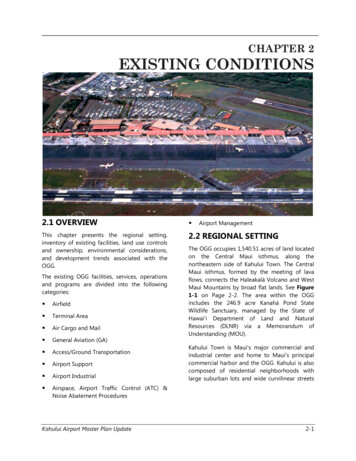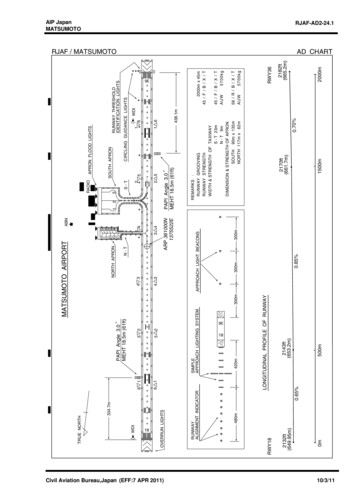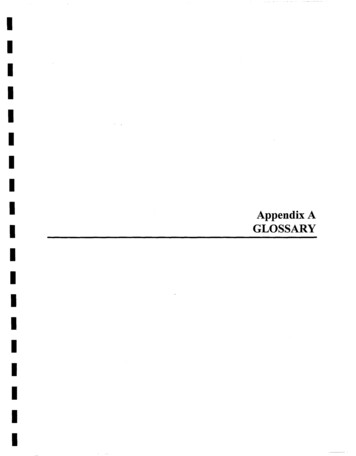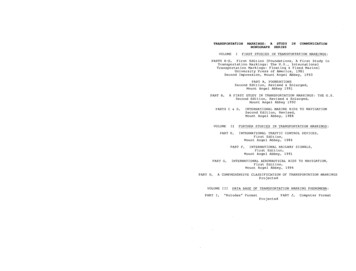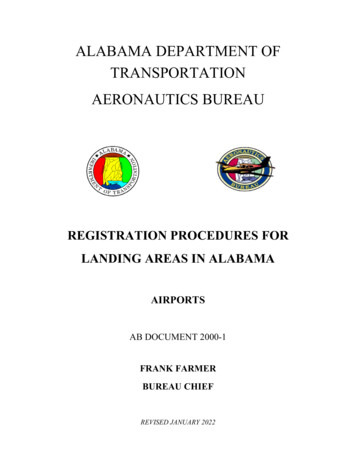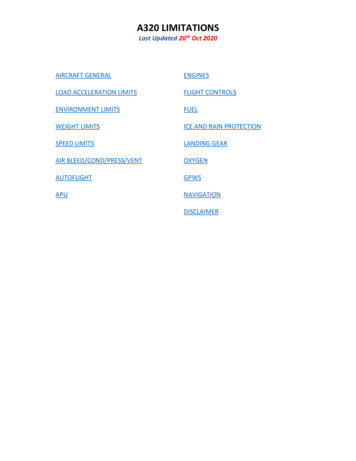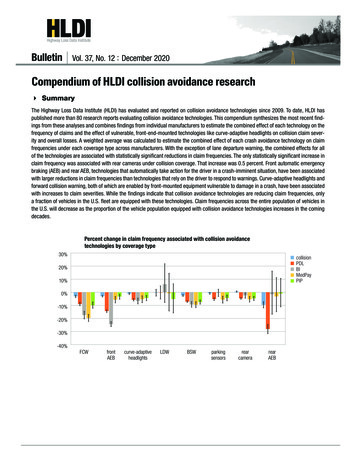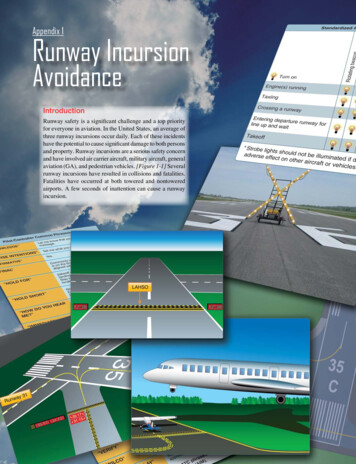
Transcription
Appendix 1Runway IncursionAvoidanceIntroductionRunway safety is a significant challenge and a top priorityfor everyone in aviation. In the United States, an average ofthree runway incursions occur daily. Each of these incidentshave the potential to cause significant damage to both personsand property. Runway incursions are a serious safety concernand have involved air carrier aircraft, military aircraft, generalaviation (GA), and pedestrian vehicles. [Figure 1-1] Severalrunway incursions have resulted in collisions and fatalities.Fatalities have occurred at both towered and nontoweredairports. A few seconds of inattention can cause a runwayincursion.1-1
Figure 1-1. Runway incursions are a top FAA safety concern thatinvolves pilots, air traffic control (ATC), and ground operations.You are expected to taxi an airplane safely whether movingto or from a runway or otherwise moving about the airport.Scenarios such as bad weather, low visibility, construction,airport unfamiliarity, time of day, distractions, fatigue, andmiscommunications with air traffic control (ATC) add greatlyto the challenge of surface navigation.This chapter is designed to help you attain an understandingof the risks associated with surface navigation and is intendedto provide you with basic information regarding the safeoperation of aircraft at towered and nontowered airports. Thischapter focuses on the following major areas: Automatic Terminal Information Service (ATIS) Notice to Airmen (NOTAMs)—http://www.faa.gov/pilots/flt plan/notams Advisory Circular (AC) 91-73, part 91 and part 135,Single-Pilot and Flight School Procedures During TaxiOperations Aeronautical Information Manual (AIM)—www.faa.gov/air traffic/publications/atpubs/aim/ AC 120-74, parts 91, 121, 125, and 135, Flight CrewProcedures During Taxi OperationsRunway Incursion OverviewApproximately three runway incursions occur each day attowered airports within the United States. The potentialthat these numbers present for a catastrophic accident isunacceptable. A runway incursion is formally defined bythe FAA as “any occurrence at an aerodrome involving theincorrect presence of an aircraft, vehicle, or person on theprotected area of a surface designated for the landing andtakeoff of aircraft.” The following are examples of pilotdeviations, operational incidents (OI), and vehicle (driver)deviations that may lead to runway incursions.Pilot Deviations: Crossing a runway hold marking without clearancefrom ATCTaxi route planning Taking off without clearance Taxi procedures Landing without clearance Communications Airport signs, markings and lighting Runway incursion overview Each section identifies best practices to help you avoid errorsthat may potentially lead to runway incursions. Although thechapter pertains mostly to surface movements for single-pilotoperations, all of the information is relevant for flight crewoperations as well.Additional information about surface operations is availablethrough the following sources: Federal Aviation Administration (FAA) RunwaySafety website—www.faa.gov/go/runwaysafety FAA National Aeronautical Navigation Services(AeroNav), formerly known as the NationalAeronautical Charting Office (NACO)—www.faa.gov/air traffic/flight info/aeronav 1-2Airport/Facility Directory (A/FD)—www.faa.gov/air traffic/flight portdirectoryOperational Incidents (OI): Clearing an aircraft onto a runway while anotheraircraft is landing on the same runway Issuing a takeoff clearance while the runway isoccupied by another aircraft or vehicleVehicle (Driver) Deviations: Crossing a runway hold marking without ATCclearanceAccording to FAA data, approximately 65 percent of allrunway incursions are caused by pilots. Additionally, 75percent of the 65 percent of runway incursions are causedby GA pilots.Causal Factors of Runway IncursionsDetailed investigations of runway incursions over the past10 years have identified three major areas contributing tothese events: Failure to comply with ATC instructions
Lack of airport familiarity Nonconformance with standard operating proceduresClear, concise, and effective pilot/controller communicationis paramount to safe airport surface operations. You mustfully understand and comply with all ATC instructions. It ismandatory to read back all runway “hold short” instructionsverbatim.Taxiing on an unfamiliar airport can be very challenging,especially during hours of darkness or low visibility. Ensureyou have a current airport diagram, remain “heads-up” witheyes outside, and devote your entire attention to surfacenavigation per ATC clearance. All checklists should becompleted while the aircraft is stopped. There is no placefor non-essential chatter or other activities while maintainingvigilance during taxi. [Figure 1-2]Not only can airport complexity contribute to a runwayincursion; it can also play a significant role in runwayconfusion. If you are operating at an unfamiliar airport andneed assistance in executing the taxi clearance, do not hesitateto ask ATC for help. Always carry a current airport diagramand trace or highlight your taxi route to the departure runwayprior to leaving the ramp.If you are operating from an airport with runway thresholdsin close proximity to one another, exercise extreme cautionwhen taking the runway. Figure 1-3 shows a perfect exampleof a taxiway leading to a runway and a runway with adisplaced threshold. If departing on Runway 36, ensurethat you set your aircraft heading “bug” to 360 , and alignyour aircraft to the runway heading to avoid departing fromthe wrong runway. Before adding power, make one lastinstrument scan to ensure the aircraft heading and runwayheading are aligned.36Figure 1-2. Heads-up, eyes outside.Runway ConfusionRunway confusion is a subset of runway incursions andoften results in you unintentionally taking off or landing ona taxiway or wrong runway. Generally, you are unaware ofthe mistake until after it has occurred.In August 2006, the flight crew of a commercial regional jetwas cleared for takeoff on Runway 22 but mistakenly linedup and departed on Runway 26, a much shorter runway. Asa result, the aircraft crashed off the end of the runway.Causal Factors of Runway ConfusionThere are three major factors that increase the risk of runwayconfusion and can lead to a wrong runway departure: Airport complexity Close proximity of runway thresholds Joint use of a runway as a taxiwayFigure 1-3. Relocated threshold.1-3
Under certain circumstances, it may be necessary touse a runway as a taxiway. For example, during airportconstruction some taxiways may be closed requiring rerouting of traffic onto runways. In other cases, departingtraffic may be required to back taxi on the runway in orderto utilize the full runway length.It is important to remain extremely cautious and maintainsituational awareness (SA). When instructed to use a runwayas a taxiway, do not become confused and take off on therunway you are using as a taxiway.Taxi Route PlanningNC-3, 08 MAR 2012 to 05 APR 2012NC-3, 08 MAR 2012 to 05 APR 2012Thorough planning is essential for safe taxi operations. Giveas much attention to planning the airport surface movementas is given to other phases of flight. [Figure 1-4]Figure 1-4. Taxi route planning helps to make airport surfacemovement safer.Notices to Airmen (NOTAMs)Time-critical aeronautical information, which is of atemporary nature or not sufficiently known in advanceto permit publication, on aeronautical charts or in otheroperational publications receives immediate disseminationby the NOTAM system. The NOTAM information couldaffect your decision to make the flight. It includes suchinformation as taxiway and runway closures, construction,communications, changes in status of navigational aids, and1-4other information essential to planned en route, terminal, orlanding operations. Exercise good judgment and commonsense by carefully regarding the information readily availablein NOTAMs. For more detailed information on NOTAMs,refer back to Chapter 1 of this handbook.Automated Terminal Information Service (ATIS)The Automated Terminal Information Service (ATIS) is arecording of the local weather conditions and other pertinentnon-control information broadcast on a local frequency in alooped format. It is normally updated once per hour but isupdated more often when changing local conditions warrant.Important information is broadcast on ATIS includingweather, runways in use, specific ATC procedures, and anyairport construction activity that could affect taxi planning.When the ATIS is recorded, it is given a code. This code ischanged with every ATIS update. For example, ATIS Alphais replaced by ATIS Bravo. The next hour, ATIS Charlie isrecorded, followed by ATIS Delta and progresses down thealphabet with every update starting back at Alpha after abreak in service of 12 hours or more.Prior to calling ATC, tune to the ATIS frequency and listen tothe recorded broadcast. The broadcast ends with a statementcontaining the ATIS code. For example, “Advise on initialcontact, you have information Bravo.” Upon contactingthe tower controller, state information Bravo was received.This allows the tower controller to verify the pilot has thecurrent local weather and airport information without havingto state it all to each pilot who calls. This also clears thetower frequency from being overtaken by the constant relayof the same information, which would result without anATIS broadcast. The use of ATIS broadcasts at departureand arrival airports is not only a sound practice but a wisedecision.Airport/Facility Directory (A/FD)The Airport/Facility Directory (A/FD) is a pilot’s manual thatprovides information on airports and other aviation facilities.The directory includes data that cannot be readily depictedin graphic form, including airport hours, runway widths,lighting codes, and fuel available. [Figure 1-5]Airport DiagramIt is essential to have a current airport diagram available forthe departure airport, as well as the arrival airport for safeoperations. [Figure 1-6] In the back section of each A/FDvolume are full page airport diagrams that can help you plansurface operations. Time should be taken to study the airportdiagram and anticipated taxi routes based on the informationprovided from the ATIS and NOTAMs.
fo5 APR 2012eused9 FEB 2012Consult NOTAMs for latest informationWarning: Refer to current foreign charts and flight information publications forinformation within foreign airspacePublished in accordance with specifications and agreements approved by theFederal Aviation AdministrationNottobto 0901ZNC-2, 08 MAR 2012 to 05 APR 2012Effective 0901ZNC-2, 08 MAR 2012 to 05 APR 2012rnavigationAIRPORT/FACILITY DIRECTORYSOUTH CENTRAL U.S.Figure 1-6. Obtain airport diagrams from the Airport FacilityFigure 1-5. Airport Facility Directory (A/FD).Directory (A/FD) or www.faa.gov/airports/runway safety/diagrams.You should not take for granted that the anticipated taxiroute will be the same taxi route received from ATC, whichis why it is so important to write down and read back the taxiclearance from ATC. Current airport diagrams are availablefor download at www.faa.gov/airports/runway safety/diagrams.Being proactive by knowing all possible taxi routes andmaintaining taxi route awareness helps mitigate runwayincursions, especially when navigating through complexintersections, known “hot spots” areas, and interveningrunways.Hot SpotsAn airport “hot spot” is typically a complex or confusingtaxiway/taxiway or taxiway/runway intersection. This areaof increased risk has either a history of, or potential for,runway incursions or surface incidents due to a variety ofcauses including airport layout, traffic flow, airport marking,signage, and lighting.It is important for you to learn and understand how to safelyfollow taxi procedures. This section addresses specific ATCinstructions that may be issued while taxiing and proceduresthat you should follow. For more information on detailedtaxi procedures to be followed at towered airports, refer toChapter 4 of the Aeronautical Information Manual (AIM).You should pay special attention to any complex intersectionsor areas designated on the airport diagram as “hot spots”to reduce the risk of a runway incursion. “Hot spots” aredepicted on airport diagrams as open circles or polygonsdesignated as “HS 1,” “HS 2,” etc. [Figure 1-7] “Hot spots”will remain charted on airport diagrams until the increasedrisk has been reduced or eliminated.Taxi ProceduresSituational Awareness (SA)Situational Awareness (SA) means understanding what isgoing on around you. Also, understanding is more thanjust information gathering—it requires gathering the rightinformation, being able to analyze it, and making decisions.1-5
HOT SPOTSPHOENIX DEER VALLEY (DVT)SW-4, 08 MAR 2012 to 05 APR 2012Figure 1-8. When taxiing, be aware of your location as it relatesto the intended taxi route, other aircraft, and vehicles operatingon the airport.Not tobeusedSW-4, 08 MAR 2012 to 05 APR 2012SW-4, 08 MAR 2012 to 05 APR 2012fornavigationFor information purposes only. Not an official airport diagramFigure 1-9. Low sun angle is obscuring the runway holding positionsign and marking at a taxiway/runway intersection.Figure 1-7. Airport diagram for Phoenix Deer Valley (DVT),Phoenix, Arizona showing where the “hot spots” are located onthe airport.SA should be used at all times when operating on an airfield.For example, prior to brake release for taxi, minimize cockpittasks, observe “sterile flight deck” procedures, and alwayspractice a “heads up, eyes out” mode while taxiing. Remainespecially vigilant of “hold short,” crossing clearances,and “hot spots,” if applicable. When taxiing, be aware ofyour location as it relates to the intended taxi route, otheraircraft that are taxiing, and vehicles operating on the airport.[Figure 1-8] If in doubt, stop, remain clear of the runway,and contact ATC.The following excerpt, taken from the A/FD, is an exampleof information available to you that helps mitigate the loss ofSA: “Taxiing aircraft should use caution in early morning andlate afternoon hours. Sun glare may make visual recognitionof signs and pavement markings difficult.” [Figure 1-9]1-6Movement and Non-Movement Area BoundaryAt towered airports, the airport surface area is divided intotwo parts: non-movement area and movement area. Thenon-movement area is defined as ramps and aprons and isnot controlled by ATC, which means you may move or taxithe airplane without clearance or communications with thecontrol tower.The movement area is defined as all taxiways and runwaysand is under the jurisdiction of the control tower, so a taxiclearance is required prior to entering into the movementarea. The boundary between the ramp and the taxiways iscalled the non-movement area boundary and is defined bytwo yellow lines: one solid and one dashed. [Figure 1-10]The solid line is located on the non-movement area side whilethe dashed yellow line is located on the movement area side.Once you are ready to taxi, ATC should be contacted for taxiinstructions. After a taxi clearance is received, movement tocross the non-movement area boundary marking and onto thetaxiway is authorized.
Read back your complete ATC clearance with your aircraftcall sign. This gives ATC the opportunity to clarify anymisunderstandings and ensure that instructions were given tothe correct aircraft. If, at any time, there is uncertainty aboutany ATC instructions or clearances, ask ATC to “say again”or ask for progressive taxi instructions.ATC Instructions—“Hold Short”Movement areaNon-movement areaFigure 1-10. Non-movement area boundary marking.ATC InstructionsTitle 14 of the Code of Federal Regulations (14 CFR) part91, section 91.123 requires you to follow all ATC clearancesand instructions. Request clarification if you are unsure of theclearance or instruction to be followed. If you are unfamiliarwith the airport or unsure of a taxi route, ask ATC for a“progressive taxi.” Progressive taxi requires the controllerto provide step-by-step taxi instructions.The most important sign and marking on the airport is thehold sign and hold marking. These are located on a stubtaxiway leading directly to a runway. They depict the holdingposition or the location where the aircraft is to stop so as notto enter the runway environment. [Figure 1-12] For example,Figure 1-13 shows the holding position sign and marking forRunway 13 and Runway 31.The final decision to act on ATC’s instruction rests with you.If you cannot safely comply with any of ATC’s instructions,inform them immediately by using the word “UNABLE.”There is nothing wrong with telling a controller that you areunable to safely comply with the clearance.Another way to mitigate the risk of runway incursions is towrite down all taxi instructions as soon as they are receivedfrom ATC. [Figure 1-11] It is also helpful to monitor ATCclearances and instructions that are issued to other aircraft.You should be especially vigilant if another aircraft has asimilar sounding call sign so there is no mistake about whoATC is contacting or to whom they are giving instructionsand clearances.Figure 1-12. Do NOT cross a runway holding position markingwithout ATC clearance.Figure 1-13. Runway 13-31 holding position sign and markinglocated on taxiway Charlie.Figure 1-11. A pilot writing down instructions from ATC.1-7
When ATC issues a “hold short” clearance, you are expectedto taxi up to, but not cross any part of the runway holdingmarking. At a towered airport, runway hold markings shouldnever be crossed without explicit ATC instructions. Do notenter a runway at a towered airport unless instructions aregiven from ATC to cross, takeoff from, or “line up and wait”on that specific runway.ATC is required to obtain a read-back from the pilot ofall runway “hold short” instructions. Therefore, youmust read back the entire clearance and “hold short”instruction, to include runway identifier and your call sign.Figure 1-14 shows an example of a controller’s taxi and “holdshort” instructions and the reply from the pilot.ControllerNovember 477ZA,runway four, taxi viaEcho, hold short runwaytwo five at taxiway Delta.PilotNovember 477ZA,runway four via Echo,hold short of runwaytwo five at Delta.Figure 1-14. Example of taxi and “hold short” instructions fromATC to a pilot.ATC Instructions—Explicit Runway CrossingAs of June 30, 2010, ATC is required to issue explicitinstructions to “cross” or “hold short” of each runway.Instructions to “cross” a runway are normally issued oneat a time, and an aircraft must have crossed the previousrunway before another runway crossing is issued. Exceptionsmay apply for closely spaced runways that have less than1,000 feet between centerlines. This applies to all runwaysto include active, inactive, or closed. Figure 1-15 showscommunication between ATC and a pilot who is requestinga taxi clearance.Extra caution should be used when directed by ATC totaxi onto or across a runway, especially at night and duringreduced visibility conditions. Always comply with “holdshort” or crossing instructions when approaching an entranceto a runway. Scan the full length of the runway and the finalapproaches before entering or crossing any runway, even ifATC has issued a clearance.1-8Pilot“Ground, November 1234ready to taxi from the GAramp with Bravo.”ATC“November 1234,Runway 27, taxi viaAlpha, hold shortRunway 31.”Pilot“November 1234,Runway 27, taxi viaAlpha, hold shortRunway 31.”ATCWhen able, tower willissue crossing clearance:“November 1234, crossRunway 31.”Figure 1-15. Communication between ATC and a pilot who isrequesting taxi procedures.ATC Instructions—“Line Up and Wait” (LUAW)ATC now uses the “line up and wait” (LUAW) instructionwhen a takeoff clearance cannot be issued immediately dueto traffic or other reasons. The words “line up and wait” havereplaced “position and hold” in directing you to taxi onto arunway and await takeoff clearance.An ATC instruction to “line up and wait” is not a clearancefor takeoff. It is only a clearance to enter the runway andhold in position for takeoff. Under LUAW phraseology, thecontroller states the aircraft call sign, departure runway, and“line up and wait.” Be aware that “traffic holding in position”will continue to be used to advise other aircraft that traffichas been authorized to line up and wait on an active runway.Pay close attention when instructed to “line up and wait,”especially at night or during periods of low visibility. Beforeentering the runway, remember to scan the full length of therunway and its approach end for other aircraft.There have been collisions and incidents involving aircraftinstructed to “line up and wait” while ATC waits for thenecessary conditions to issue a takeoff clearance. An OIcaused a 737 to land on a runway occupied by a twin-engineturboprop. The turboprop was holding in position awaitingtakeoff clearance. Upon landing, the 737 collided with thetwin-engine turboprop.When ATC instructs you to “line up and wait,” they shouldadvise you of any delay in receiving your takeoff clearance.Possible reasons for ATC takeoff clearance delays mayinclude other aircraft landing and/or departing, waketurbulence, or traffic crossing an intersecting runway. Iflanding traffic is a factor, ATC is required to: Inform you of the closest traffic requesting a full-stop,touch-and-go, stop-and-go, option, or unrestricted lowapproach on the same runway.
When ATC issues intersection “line up and wait”instructions and takeoff clearances, the taxiwaydesignator is included.NOTE: At night or in low visibility, consider lining upslightly left or right of centerline when holding for takeoffso that your aircraft is visible and can be differentiated fromrunway lights.ATC Instructions—“Runway Shortened”You should review NOTAMs in your preflight planning todetermine any airport changes that will affect your departureor arrival. When the available runway length has beentemporarily or permanently shortened due to construction,the ATIS includes the words “warning” and “shortened” inthe text of the message. For the duration of the constructionwhen the runway is temporarily shortened, ATC willinclude the word “shortened” in their clearance instructions.Furthermore, the use of the term “full length” will not beused by ATC during this period of the construction. Someexamples of ATC instructions are: “Runway 36 shortened, line up and wait.” “Runway 36 shortened, cleared for takeoff.” “Runway 36 shortened, cleared to land.”When an intersection departure is requested on a temporarilyor permanently shortened runway during the construction,the remaining length of runway is included in the clearance.For example, “Runway 36 at Echo, intersection departure,5,600 feet available.” If following the construction, therunway is permanently shortened, ATC will include theword “shortened” until the A/FD is updated to include thepermanent changes to the runway length.Pre-Landing, Landing, and After-LandingWhile en route and after receiving the destination airportATIS/landing information, review the airport diagramand brief yourself as to your exit taxiway. Determine thefollowing: Are there any runway hold markings in close proximityto the exit taxiway? Do not cross any hold markings or exit onto anyrunways without ATC clearance.Aircraft LightsThe use of aircraft exterior lights during all flight operationsmake an aircraft operating on the airport surface moreconspicuous and help convey location and intent to you andATC. Some examples of aircraft exterior light usage are listedbelow and shown in Figure 1-16.Standardized Aircraft LightingTurn onLanding lightsIf a takeoff clearance is not received within 90 secondsafter receiving the “line up and wait” instruction,contact ATC immediately.Logo lights Taxi lightsIf advised of a reason for the delay, or the reason isclearly visible, expect an imminent takeoff clearanceonce the reason is no longer an issue.Strobe light* After landing, use the utmost caution where the exit taxiwaysintersect another runway, and do not exit onto another runwaywithout ATC authorization. Do not accept last minuteturnoff instructions from the control tower unless you clearlyunderstand the instructions and are at a speed that ensures youcan safely comply. Finally, after landing and upon exitingthe runway, ensure your aircraft has completely crossed overthe runway hold markings. Once all parts of the aircraft havecrossed the runway holding position markings, you must holdunless further instructions have been issued by ATC. Do notinitiate non-essential communications or actions until theaircraft has stopped and the brakes set.Navigation/Position lightsAdvise the landing traffic that traffic is holding inposition on the same runway.Rotating beacon Engine(s) runningTaxiingCrossing a runwayEntering departure runway forline up and waitTakeoff* Strobe lights should not be illuminated if doing so will have anadverse effect on other aircraft or vehicles.Figure 1-16. Standard aircraft lighting. Engines running—before starting engines, turn on therotating beacon. Taxiing—prior to commencing taxi, turn onnavigation/position, strobe (only if the use of themdoes not adversely affect other aircraft), taxi, and logolights, if available.1-9
Crossing a runway—illuminate all external lightswhen crossing a runway. You should consider anypossible adverse affects that illuminating the forwardfacing lights may have on the vision of other pilots orground personnel during runway crossings. “Line up and wait”—when entering the departurerunway without takeoff clearance, turn on all exteriorlights (except landing lights) to make your aircraftmore conspicuous. Departure runway—when entering the departurerunway after takeoff clearance is received or whencommencing takeoff roll, turn on landing lights.Nontowered AirportsMany GA airports, even those with operating ATC towers,may not have airport signage and markings that are requiredat airports certificated by the FAA. In fact, you may observea wide range of airport signage and markings from one GAairport to the next.There is no substitute for alertness while in the vicinity of anairport. It is essential that pilots be alert and look for othertraffic and exchange traffic information when approachingor departing an airport without an operating control tower.This is of particular importance since other aircraft may nothave communication capability or, in some cases, pilots maynot communicate their presence or intentions when operatinginto or out of such airports. To achieve the greatest degree ofsafety, it is essential that all radio-equipped aircraft transmit/receive on a common frequency identified for the purposeof airport advisories.An airport may have a full or part-time tower or FlightService Station (FSS) located on the airport, a full or parttime UNICOM station, or no aeronautical station at all. Thereare three ways for pilots to communicate their intention andobtain airport/traffic information when operating at an airportthat does not have an operating tower: by communicatingwith an FSS, a UNICOM operator, or by making a selfannounced broadcast.Many airports are now providing completely automatedweather, radio check capability, and airport advisoryinformation on an automated UNICOM system. Thesesystems offer a variety of features, typically selectable bymicrophone clicks, on the UNICOM frequency. Availabilityof the automated UNICOM is published in the A/FD andapproach charts.NOTE: Line up and wait/holding in position is notrecommended at nontowered airports.1-10CommunicationsIn order to have safe surface operations, it is imperativethat you maintain good communication with ATC. Thecontroller’s understanding can be enhanced by you respondingappropriately and using standard phraseology. Figure 1-17shows a detailed glossary of phraseology that is commonlyused in surface operations. Guidelines for clear and accuratecommunications include the use of proper communicationprocedures when contacting ATC. Your initial transmissionto ATC should contain the following elements: Who you are—aircraft’s complete call sign. Where you are on the airport. What you want—you should think about what youwant to say before communicating it. Alphabetical code for the ATIS.NOTE: You must be alert for stuck microphones.Prior to contacting ATC, transmissions should be wellthought out before keying the transmitter. Know what needsto be said and always check the radio frequencies to ensurethat the proper one is being used to transmit. Communicationwith ATC should be concise and to the point. For unusualsituations or lengthy communications, initial contact shouldbe established. Then, in the next transmission, describe thesituation. Keep in mind that other aircraft are waiting tocontact ATC, so transmissions should be kept to a minimumunless it is an emergency situation.While communicating with ATC, focus on what the controlleris instructing and do not perform any non-essential tasks.Refer to the AIM, Chapter 5, Section 5, Pilot/ControllerRoles and Responsibilities. Read back any “hold short”of runway instructions issued by ATC. This readback should include the specific runway designator andtaxiway intersection when appropriate, so if there are anymisunderstandings or errors, they are obvious to ATC.A read back presents the first and most efficient opportunity tocatch any miscommunications. It provides a “reality check” intwo ways: it tells the controller, “This is what the pilot heard;”and it provides the controller the opportunity to reaffirm thatis what he/she meant to say. For detailed information aboutradio communication phraseology and techniques, refer toChapter 4, Section 2 of the AIM.Understanding the NOTAMs for the airport is very importantwhen communicating with ATC. NOTAMs provideinformation regarding taxiway/runway closures. With properknowledge of the airpor
This chapter is designed to help you attain an understanding of the risks associated with surface navigation and is intended to provide you with basic information regarding the safe operation of aircraft at towered and nontowered airports. This chapter focuses on the following major areas: Runway incursion overview Taxi route planning
